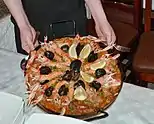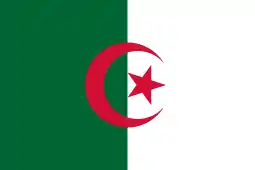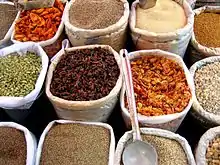Algerian cuisine
The cuisine of Algeria is influenced by Algeria's interactions and exchanges with other cultures and nations over the centuries. It is characterized by a wealth derived from both land and sea products. Conquests or demographic movement towards the Algerian territory were two of the main factors of exchanges between the different peoples and cultures (Berbers, Arabs, Turks, Andalusians, French and Spaniards). This cuisine is a Mediterranean and North African cuisine with Berber roots.
| Cuisine of Algeria | |
|---|---|
 An Algerian sea food dish | |
| Standard Arabic | |
| Abjad | المطبخ الجزائري |
| Romanization | Al-Maṭbakh al-Jazā’irī |
| Algerian Arabic | |
| Abjad | الكوزينة تاع دزاير |
| Latin | El Couzina ta3 Dzaïr |
| Tamazight | |
| Tifinagh | ⵜⴰⴽⵓⵣⵉⵏⵜ ⵏ ⴷⵣⴰⵢⴻⵔ |
| Latin | Takuzint n Dzayer |
| Abjad | ثاكوزينت ن زّاير |
| French | |
| French | Cuisine algérienne |
| IPA | [kɥizin alʒeʁjɛn] |
| Part of a series on the |
| Culture of Algeria |
|---|
 |
| People |
| Art |
Algerian cuisine offers a variety of dishes depending on the region and the season, but vegetables and cereals remain at its core. Most of the Algerian dishes are centered around bread, meats (lamb, beef or poultry), olive oil, vegetables and fresh herbs. Vegetables are often used for salads, soups, tajines, couscous and sauce-based dishes. Of all the Algerian traditional dishes available, the most famous one is couscous, recognized as a national dish.
Pork consumption is forbidden to Muslims in Algeria, in accordance with Sharia, the Islamic law.
Ingredients
Algeria, like other Maghreb countries, produces a large range of Mediterranean fruits and vegetables and even some tropical ones.[1] Lamb is commonly consumed. Mediterranean seafood and fish are also eaten and produced by the little inshore fishing.
Spices used in Algerian cuisine are dried red chilli of different kinds, caraway, twenty-seven spices are combined for the famous Algerian spice mixture ras el hanout, cumin, cinnamon, turmeric, ginger, paprika, coriander, saffron, mace, cloves, fennel, anise, nutmeg, cayenne pepper, fenugreek, black pepper.

Meats
Algerians consume a high amount of meat, as it is found in almost every dish. Mutton is the most eaten meat in the country, Poultry and beef are also used, other uncommon types of meat such as game, birds and venison and they are considered a delicacy. In the south, dromedary meat is also eaten.
Vegetables
Vegetables that are commonly used include potatoes (batata/betetè), carrots (zrodiya / sennariya), Turnip (left), onions (bsel/besla), tomatoes (tomatish/tømètish/t'matem), zucchini (corget / qar'a / khyar), garlic (ethoum), cabbages (cromb), eggplant (bidenjan), Olives (zéton) , pennyroyal (fliou), Cardoon (korchef) , broad bean (fool), Chickpea (homoss), and Chili pepper (felfel).
Vegetables are often used in stews tagine or (jwaz/djwizza) and soups (chorba or harira or jari) or simply fried or boiled.
Dishes

A common and one of the most favorite dishes of Algerian cuisine is couscous,[2] with other favorites such as shakshouka, Karantita, and marqa bel a'assel, a speciality from Tlemcen. A popular Algerian meat is merguez, an originally Berber sausage.[3][4][5]
Algeria has four well-known traditional soups consumed throughout the country: chorba, harira, djari and tchicha. These traditional Algerian soups are served at the beginning of the meal as an entree and are mainly prepared from lamb, mutton or chicken, chickpeas, tomatoes, vermicelli, wheat, spices and different vegetables and legumes. These varied soups are the most popular during the holy month of Ramadan.
There are many different types of Algerian salads, including both raw and cooked vegetables, served either hot or cold. Hot salads include zaalouka, an aubergine and tomato mixture, and chakchouka, a mixture of tomatoes, smoked green peppers, garlic , eggs and spices. Influenced by both the Algerian and Mediterranean cuisines, chakchouka may include beetroot or anchovies. There are also dishes of Spanish origin in Algeria, like the Gaspacho Oranais, an Algerian version of a Manchego dish.[6]

Algerians commonly use tajines, a earthenware pot, to cook. Algerian chefs take much pride in cooking skills and methods and their many secrets lie in the variety of ways they mix special spices.
Additional dishes

- Bourek – fried spring rolls with various stuffing, including meat, tuna, potato, and cheese.
- Mhajeb – flat bread stuffed with onions and tomato sauce.
- Shakshouka, chakshoka, shakhshosha – a mixture of onions, tomato, bell peppers, zucchini and eggs. There many versions, depending on the region.
- Chorba frik or jari – a tomato-base soup with lamb
- Frites-omelette – French fries with eggs
- Dolma – stuffed vegetables cooked in a stock
- Tagine or Jwaz – a stew consisting of vegetables (potatoes, carrots, onions, or tomatoes) and meat, sometimes navy beans, kidney beans are included; it is a peasant food
- Tajine hlew – a sweet saucy dish that has meat with dried apricots and prunes.
- Lobia – fasolada- eaten in the winter a thick Stew of beans and chunks of carrots and potatoes, there is many versions of this with lentils, kidney beans and other legumes
- Chtit'ha – consists of poultry, onions and eggs in a red stock of tomatoes. It is usually served at weddings. The recipe varies depending on the region.
- Hmis or slata mshwiya – roasted bell pepper with tomato sauce and olive oil

Desserts and drinks
Seasonal fruits are typically served as a dessert at the end of meals.
Common pastries include dziriyat, garn ghzal, baqlawa, bradj, makroudh, kalb elouz, zlabiya, and griwech. Griwech is a deep-fried pretzel-shaped dough, soaked in honey and sprinkled with sesame seeds; it is commonly eaten during the month of Ramadan. Many pastries are prepared for special occasions like for Eid-al-fitr and weddings.


Green tea with mint is generally drunk in the afternoon and for ceremonies with pastries. Algerians are heavy coffee consumers; thick espresso and black coffee are very popular, Algerian breakfast consists of a latte coffee with croissants or bread with butter or any Algerian sweets etc. Fruit juice and soft drinks, called gazouz, are common and often drunk daily.
Algeria previously produced a large quantity of wine during the French colonization but production has decreased since its independence; however, there are some secular activists that want to produce wine.
Bread
Between 1976 and 1984, the average Algerian family spent around 56% of their income on food and drink, and more than 10% of that number was spent on bread and other cereal products. Bread is thought to contain God’s blessing, baraka. It is traditionally seen as a symbol of life and functions in rituals symbolic of life, fertility and abundance.[7]

Classes of breads
Khubz as-dâr: wheat flour, water, salt and yeast. Traditionally flat and round, a few centimeters thick, made at home and commonly baked in a gas oven or communal oven.
Khubz at-tajîn or matlû: wheat semolina, yeast, water and salt. Flattened pan-bread (French: galette), baked in a previously heated earthenware or cast-iron plate on a fire. Variations are made by the quality of the leavening agent, by adding barley or sorghum, bran, or by making it corn-based.
Khubz-ftir, raqâq, rfîs" or "tarîd: well-kneaded, unleavened dough, baked for half a minute on a convex sheet of brass or iron, balanced on stones over a fire. This is a preferred method for those living nomadic lives due to easy transportation of pan and little amount of fuel necessary.
French baguettes: white, leavened wheat flour. Bought at bakery or street vendor, but never made at home due to access to mills powered by electricity. Power shortages prevent consumption of this bread, and often Algerians turn to home-made breads that are milled by women’s hands.[7]

Algerian bread
French bread tends to be given more value in terms of taste and quality in that it was commonly associated to being more suitable to higher standards. However, the white inner parts of a baguette are thought to be unhealthy and will regularly be thrown away, and the bread is frequently associated with constipation. Algerian breads, on the other hand, are considered more nutritive, rich and tasteful and seldom go to waste. Because French breads harden over night or become chewy when put away in plastic bags, it is hard to find usage for them, so they are thrown away with more frequency than Algerian breads that can be reheated or reutilized as edible food utensils or even bird feed. In the context of rituals, only Algerian bread is thought suitable. Breads offered to guests should be homemade, as it signifies the essence, intimacy, and qualities of the family. In daily practices, it is also a sign of wealth and affluence if one has extra bread at the table, and making bread at home can be considered a sign of familial economic independence.[7]
See also
References
- "Food in Algeria". Food in Every Country (website). Accessed May 2010.
- "Luce Ben Aben, Moorish Women Preparing Couscous, Algiers, Algeria". World Digital Library. 1899. Retrieved 2013-09-26.
- French words: Past, Present, and Future. M.H. Offerd. 2001. Page 89.
- Research in African Literatures. Volume 34. 2003. Page 34.
- Merquez and Qadid, North-African preserved meats.http://www.cliffordawright.com/caw/food/entries/display.php/topic_id/20/id/41/.
- "Gaspacho oranais ou manchego". Coundris.chez-alice.fr. Retrieved 2014-08-27.
- Jansen, Willy. “French Bread and Algerian Wine: Conflicting Identities in French Algeria.” In Food, Drink and Identity: Cooking, Eating and Drinking in Europe Since the Middle Ages, edited by Peter Scholliers, 195-218. Oxford: Berg, 2001
External links
| Wikimedia Commons has media related to Cuisine of Algeria. |

